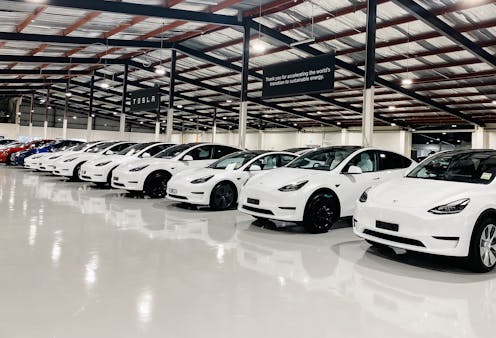Australia is failing on electric vehicles. California shows it's possible to pick up the pace
- Written by Scott Hardman, Professional Researcher, Electric Vehicle Research Center, University of California, Davis

Among the many similarities between California and Australia, both are impacted by bushfires and climate change, and both are home to larger cars and trucks[1] than is the norm in developed countries. They are dissimilar, though, when it comes to electric vehicles and vehicle regulations. While California has been pursuing low-carbon and electric vehicles for decades, Australia has trailed most developed nations.
Plug-in electric vehicles accounted for 16% of new light-duty vehicle sales[2] in California in the first half of 2022. In Australia, electric vehicle sales are only 2% of the market[3], and mostly from one carmaker, Tesla.
Australia, a country with no vehicle fuel economy[4] or CO₂ emissions regulations[5], is debating how to move forward. The local auto industry suggests Australia needs a slow transition[6] to electric vehicles and should lag the United States, Europe, China and neighbouring New Zealand. Compared to proposed European vehicle emission standards of 43 grams of carbon dioxide per kilometre in 2030[7], the local industry proposes 98-143g CO₂/km[8] (for light cars and SUVs).
Read more: The road to new fuel efficiency rules is filled with potholes. Here's how Australia can avoid them[9]
The proposed Australian target would result in a slow transition, which new research[10] suggests will have little or no effect on the transport sector’s CO₂ emissions.
The rationale for a slow transition is the same as was heard for decades in California: electric vehicle prices are too high, there isn’t enough infrastructure to support these vehicles, their driving ranges are too short, and certain models aren’t available (electric utes[11], for example).
Read more: The surprising history of how electric vehicles have played the long game and won[12]
These concerns have some validity, but are largely out of date. Australia in 2022 faces a very different situation from California when it started down the electric vehicle path.
Let’s deal with why each of these four concerns might now be overstated.
1. Limited range
Drivers in both Australia and California travel similar distances per year. In both regions, most trips are well within electric vehicle range[13].
Further, in both regions most households own two vehicles. This means buyers can, if needed, use another vehicle for longer trips.
Electric vehicle range has also improved[14]: the average range of available electric vehicles in 2013 when electric vehicle sales in California reached Australia’s current level of 2% was 179 kilometres (111 miles). Now, it’s 443 kilometres.

















